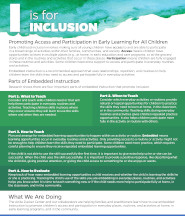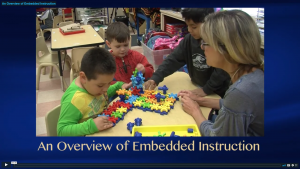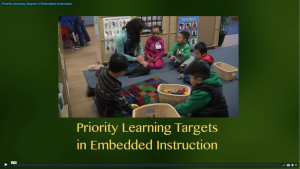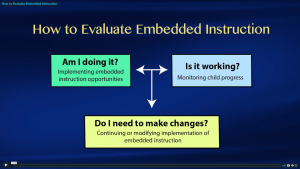A to Z’s of Early Childhood
The Science of Child Development and Learning
I is for Inclusion
Promoting Access and Participation in Early Learning for All Children
Early childhood inclusion involves making sure all young children have access to and are able to participate in a broad range of activities within their families, communities, and society.1 Access means children have opportunities to learn in multiple places (e.g., at home, in early education and care programs, or at the grocery store) and in the routines and activities that occur in these places. Participation means children are fully engaged in these routines and activities. Some children need extra support to access and participate in everyday routines and activities.
Embedded instruction2,3 is a recommended approach that uses the 3R’s of Early Learning: Relationships, Repetition, Routines ™ to help children learn the skills they need to access and participate fully in everyday activities.4,5,6
Part 1. What to teach
Part 2. When to teach
Consider which everyday activities or routines provide natural or logical opportunities for children to practice the skills they need to learn at home, in the classroom, or in the community. Teaching skills during everyday routines and activities gives children repeated practice opportunities. It also helps children participate more fully in the activity or routine with others.2,3
Learn more about routines
Learn More About Repeated Opportunities to Practice Skills Within Routines
Part 3. How to teach
Plan and arrange for embedded learning opportunities to happen within an activity or routine. Embedded means learning opportunities occur in everyday routines and activities. Only providing access to a routine or activity might not be enough to help children learn the skills they need to participate.6,7 Some children need more practice, which requires careful planning to ensure they receive repeated embedded learning opportunities.
If the child is not able to use the skill successfully the first time, it is important to give extra help so he or she can be successful. When the child uses the skill successfully, it is important to provide a positive response, like describing what the child did, giving positive attention, or giving the child access to something he or she enjoys or wants.2,3,8
Part 4. How to evaluate
What We Are Doing
The Anita Zucker Center and our collaborators are helping families and practitioners learn how to use embedded instruction to promote children’s access and participation in everyday places, routines, and activities at home, in early learning programs, and in the community.
Learn More:
- Embedded Instruction for Early Learning
Learn about Embedded Instruction, a teaching model to support preschool children with disabilities. - Embedded Instruction for Early Learning-California Project
California education agencies have partnered with experts in Embedded Instruction to implement these practices in their classrooms. - Center Members Collaborate with FSU and the Early Steps State Office on Professional Development for Providers
With the help of Early Steps, UF and FSU are collaborating on professional development at three centers in Florida. - Tools for Early Steps Teams (TEST) Toolkit
Learn about how providers in the state of Florida collaborate with families to promote positive outcomes for children who are receiving services through an Individualized Family Service Plan.
Center Resources
- A to Z’s of Early Childhood: E is for Everyday Learning Opportunities
Learn more about Letter E of the A to Z’s, which is all about everyday learning opportunities. - Home Activity Matrix (.pdf)
Use this tool to share information and plan ways to create opportunities for children to practice targeted skills during everyday routines and activities at home and in the community. - Embedded Instruction for Early Learning Video Series
This video series outlines Embedded Instruction, from implementation to evaluation.
Other Resources
- DEC/NAEYC Joint Position Statement on Early Childhood Inclusion
Read about why a sense of belonging is important for all children, according to the Division for Early Childhood and the National Association for the Education of Young Children. - Policy Statement on Inclusion of Children with Disabilities in Early Childhood Programs
This joint statement from the U.S. Department of Education and U.S. Department of Health and Human Services provides an outline for increasing inclusion in early childhood programs. - Division for Early Childhood (DEC) Recommended Practices
The DEC offers inclusion guidance for parents and caregivers of children who have or who are at risk for developmental delays or disabilities. - Head Start Center for Inclusion
Resources and recommendations from Head Start on how to create inclusive learning environments for early childhood learning centers.
Articles by Center Members and Other Collaborators
- Salisbury, C., Woods, J., Snyder, P., Moddelmog, K., Mawdsley, H., Romano, M., & Windsor, K. (2018). Caregiver and provider experiences with coaching and embedded intervention. Topics in Early Childhood Special Education, 38(1), 17-29. https://doi.org/10.1177/0271121417708036
- Snyder, P. A., McLaughlin, T., & Bishop, C. (2018). Maximizing contextually relevant learning opportunities through embedded instruction. In P. A. Snyder & M. L. Hemmeter (Eds.), Instruction: Effective strategies to support engagement, learning, and outcomes: DEC Recommended Practices Monograph Series (No. 4, pp. 51-64). Division for Early Childhood.
- Woods, J., Snyder, P. A., & Salisbury, C. (2018). Embedded practices and intervention with caregivers (EPIC): Linking instruction and family capacity-building recommended practices. In P. A. Snyder & M. L. Hemmeter (Eds.), Instruction: Effective strategies to support engagement, learning, and outcomes: DEC Recommended Practices Monograph Series (No. 4, pp. 145-158). Division for Early Childhood.
- Snyder, P., Hemmeter, M. L., McLean, M., Sandall, S., McLaughlin, T., & Algina, J. (2018). Effects of professional development on preschool teachers’ use of embedded instruction practices. Exceptional Children, 84(2), 213-232. https://doi.org/10.1177/0014402917735512
- Snyder, P. A., Rakap, S., Hemmeter, M. L., McLaughlin, T. W., Sandall, S., & McLean, M. E. (2015). Naturalistic instructional approaches in early learning: A systematic review. Journal of Early Intervention, 37(1), 69-97. https://doi.org/10.1177/1053815115595461
References
- Division for Early Childhood, & National Association for the Education of Young Children. (2009). Early childhood inclusion: A joint position statement of the Division for Early Childhood (DEC) and the National Association for the Education of Young Children (NAEYC). The University of North Carolina, FPG Child Development Institute. https://www.naeyc.org/sites/default/files/globally-shared/downloads/PDFs/resources/position-statements/ps_inclusion_dec_naeyc_ec.pdf
- Snyder, P., Hemmeter, M. L., McLean, M., Sandall, S., McLaughlin, T., & Algina, J. (2018). Effects of professional development on preschool teachers’ use of embedded instruction practices. Exceptional Children, 84(2), 213-232. https://doi.org/10.1177/0014402917735512
- Snyder, P., Hemmeter, M. L., McLean, M. E., Sandall, S. R., & McLaughlin, T. (2013). Embedded instruction to support early learning in response to intervention frameworks. In V. Buysse & E. S. Peisner-Feinberg (Eds.), Handbook of response to intervention in early childhood (pp. 283-300). Brookes.
- Division for Early Childhood. (2014). DEC recommended practices in early intervention/early childhood special education 2014. http://www.dec-sped.org/recommendedpractices
- Snyder, P. A., Rakap, S., Hemmeter, M. L., McLaughlin, T. W., Sandall, S., & McLean, M. E. (2015). Naturalistic instructional approaches in early learning: A systematic review. Journal of Early Intervention, 37(1), 69-97. https://doi.org/10.1177/1053815115595461
- Carta, J., & Snyder, P. (2019). Fifty years of research on children with disabilities and their families: From changing behaviors to transforming lives. In B. H. Wasik & S. L. Odom (Eds.), Celebrating 50 years of child development research: Past, present, and future perspectives (pp. 235-254). Brookes.
- Carta, J. J., Schwartz, I. S., Atwater, J. B., & McConnell, S. R. (1991). Developmentally appropriate practice: Appraising its usefulness for young children with disabilities. Topics in Early Childhood Special Education, 11(1), 1-20. https://doi.org/10.1177/027112149101100104
- Barton, E. E., Bishop, C. C., & Snyder, P. (2014). Quality instruction through complete learning trials: Blending intentional teaching with embedded instruction. In K. Pretti-Frontczak, J. Grisham-Brown, & L. Sullivan (Eds.), Blending practices for all children: Young Exceptional Children Monograph Series (No. 16, pp. 73-96). Division for Early Childhood.
Receive Additional Support
The complete 3R’s of Early Learning downloadable video recordings (including the A to Z’s of Early Childhood) for use in the field of childhood development to facilitate learning are available for purchase.
If you would like to purchase these resources or speak with a member of our team for help in providing professional development, please complete this contact form.





